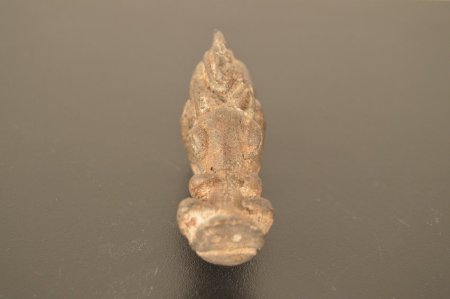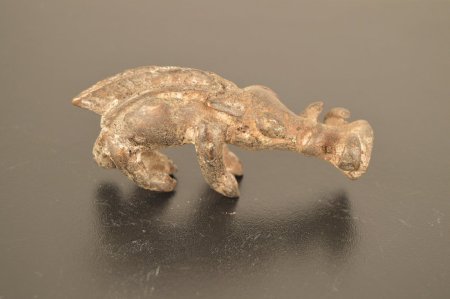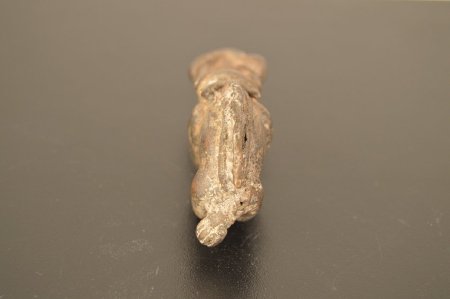Title:
Bronze Goldweight, WartHog
Object Name:
Figure, Goldweight, Bronze
Other Name:
Figure, Goldweight, Bronze, WartHog
Place of Origin:
Asante, Ghana, Africa
Provenance:
Aboriginal Indigenous Art.
H = 1—1/2"
W = 1—1/4"
D = 3—3/4"
The extent of the gold trade among the Akan people encouraged the use of brass and bronze gold—weights which are cast using the "lost—wax" process and have geometric or figurative shapes. Western scholars have identified two major periods of gold—weight production.
The first period dates from 1400 to 1720 and is thought to have been the result of influence of traders from the Mali empire. These weights are thick and usually geometrically shaped. Figurative weights are rare. They are large in size (7—10 cm.) and usually lack detail.
Weights produced during the second period date from 1720 to 1930. They are either geometric or figurative and show a greater variety of shape and detail. For example, animals, proverbs, or more simply, people doing everyday activities, have been represented.
Bacquart, P. 33
H = 1—1/2"
W = 1—1/4"
D = 3—3/4"
The extent of the gold trade among the Akan people encouraged the use of brass and bronze gold—weights which are cast using the "lost—wax" process and have geometric or figurative shapes. Western scholars have identified two major periods of gold—weight production.
The first period dates from 1400 to 1720 and is thought to have been the result of influence of traders from the Mali empire. These weights are thick and usually geometrically shaped. Figurative weights are rare. They are large in size (7—10 cm.) and usually lack detail.
Weights produced during the second period date from 1720 to 1930. They are either geometric or figurative and show a greater variety of shape and detail. For example, animals, proverbs, or more simply, people doing everyday activities, have been represented.
Bacquart, P. 33
Description:
Lost wax cast, bronze goldweight. Warthog with large round nose, two sets of tusks, one larger set towards the front, and a smaller set towards the back of mouth area. Large round protruding eyes. Four short legs, back two bent in half sitting position. Row of hair along back, short stubby tail. Multi—colored oxidation over entire surface. From white to light green, to a tannish brown color.
Collection:
Finley Collection
Material:
Bronze
Used:
Ritually Used
Technique:
Lost Wax Cast
Owned:
Art Department, Missouri Southern State University
Accession#:
2014.1.99



